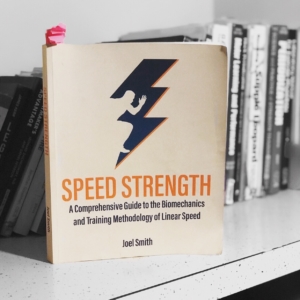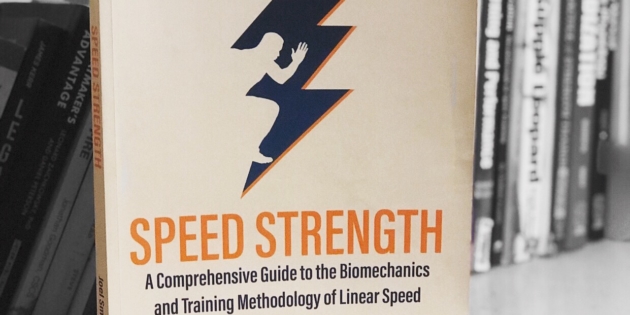From Joel Smith’s book: Speed Strength: A Comprehensive Guide to the Biomechanics and Training Methodology of Linear Speed
1) “Athletic posture” seen in all primal movements (acceleration, jumping, top-end speed, and Oly lifting second pull) is not what is traditionally taught
- Joel and Adarian Barr say athletic posture has a few features: 1) the xiphoid forward, 2) a “long tailbone”, 3) weight on the inside edge of the feet, and 4) engaged groin and TFLs
This looks quite different than the butt back-chest up-knees out position we are taught to be athletic posture. Sure, knees out works well for heavy squats, but heavy squats aren’t the same as jumping and sprinting. And what exactly are we teaching in snap downs? It’s definitely not the “athletic posture” Joel and Adarian are talking about. How much of what we do in the weight room could actually hurt performance because our concepts are wrong?
“Athletes with massive weight room numbers, but who can’t reciprocate that in sprinting and jumping, are almost always in patterns where they lack explosive pronation.”
2) Look at the shin angle to know about an athlete’s acceleration. Shin angle can guide weight room transfer to acceleration.
The shin tells us which direction an athlete is applying force. More parallel shin to the ground – horizontal force. More perpendicular shin to the ground – vertical force. If we’re interested in team sport acceleration, we need a more parallel shin with the ground which will produce high horizontal forces.
“Good shin angles distinguish mediocre accelerators from great ones.”
In the weight room: Sit back, knees behind the toes, hip drive!!! type squatting probably has less transfer to acceleration than a squat where the shins and the torso are more matching. Front squats, sport back squats (Cal Dietz), and knees-forward trap bar deadlifts probably work better for assisting in acceleration.
3) Anterior pelvic tilt in athletes, assuming it’s not causing issues, is not something to fix
As Dr. Quinn Henoch eluded to, hip extension and anterior pelvic tilt are normal, coordinative, and paired with runners. Not only this, but it could provide benefit:
“The advantages of anterior pelvic tilt and resulting lordotic posture are believed to be an increased hip extension, which allows the running and jumping athletes to apply force over a longer time resulting in a greater impulse.” – Kritz and Cronin (2008) Study here
4) 90-degree arm swing drill: Doing more harm than good
If athletes have not been taught to do this, they will likely self-organize their own arm swing for sprinting. No elite sprinters have “their arms at 90 degrees, front to back, during the entire gait pattern.”
“Rigid front-to-back arm swinging at a constant 90 degrees of elbow flexion is one of the worst cues in all of sports performance. It is a guaranteed means to limit an athlete on their maximal speed ceiling, and often has to be undone later in life.”
5) Fast sprinting requires muscle relaxation, heavy lifting can inhibit your ability to fully relax muscles
There are numerous benefits to developing strength in the weight room. But there are also potential negatives that we don’t talk about. Extremely fast movements require quick muscle contraction and relaxation. Heavy, grinding strength work doesn’t allow for quick muscle relaxation. Powerlifting-type training, done in excess, could interfere with the coordination of high velocity movements.
It’s wise to pair heavy strength work with some form of high velocity movement (e.g.: French Contrast Method). Joel also recommends doing some form of dynamic activity following a strength training session like bounds or sprints to “rewire” ourselves towards these types of movements.
“The regular use of traditional strength training methods has an effect on reducing an athlete’s ability to relax a muscle completely”
7) Sprint and jump to get stronger in the weight room
Explosive movements like maximal jumps and sprints achieve greater peak muscle outputs and total muscle recruitment than heavy squats and deadlifts. Increasing the dosage of jumping and sprinting can help athletes reach new levels of maximal strength in barbell movements because of this heightened recruitment.
“Maximal sprinting, jumping and plyometric training will drive lift numbers up, often beyond what strength training alone could bring one’s maximal lift number to!”
8) Cleans have a different toe-off than jumping or sprinting
In cleans, the toe-off comes from the outside of the foot – the 3rd, 4th, and 5th toes.
In sprinting, there is pronation with toe-off and it comes from rolling through the big toe. This paints a picture of the differences in traditional cleans versus sprints (pushing off the outer digits versus pushing through the medial arch and inside edge of foot). A similar pronation is seen in jumping.
“For optimal performance of the Olympic lifts in terms of athletic benefit, athletes must find the medial arch (inside edge of foot) early in the second pull.”
9) Train the hip flexors for the glutes
Improving tone of the hip flexors can help with joint centration of the femur. On the opposite side, this helps the glute perform its job. A “weak” or “inactive” glute could be helped along with basic seated or standing hip flexor exercises.
“Remedial single joint hip flexion exercises can be a very powerful means to attain better glute functionality through joint centration of the femur.”
10) Question to ask
In the weight room, should we be specific to the sport OR should we be more about the general neural and physiological components, leaving specificity to the sport itself?
Purchase Joel’s book here.



